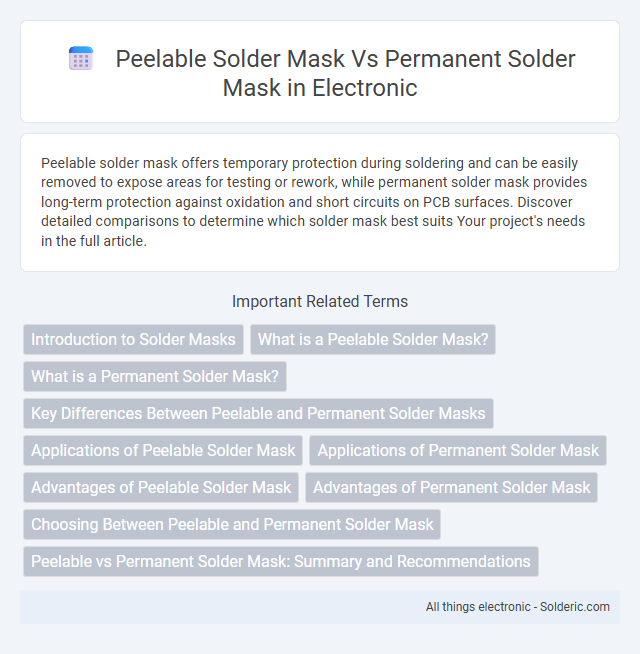Peelable solder mask offers temporary protection during soldering and can be easily removed to expose areas for testing or rework, while permanent solder mask provides long-term protection against oxidation and short circuits on PCB surfaces. Discover detailed comparisons to determine which solder mask best suits Your project's needs in the full article.
Comparison Table
| Feature | Peelable Solder Mask | Permanent Solder Mask |
|---|---|---|
| Definition | Temporary protective layer that can be peeled off after soldering. | Durable protective coating permanently bonded to the PCB. |
| Application | Used during wave soldering to protect sensitive areas. | Applied for long-term protection against oxidation and shorts. |
| Removal | Manually peeled off after the soldering process. | Not removable without damaging the PCB. |
| Protection | Short-term protection during manufacturing. | Long-term mechanical and chemical protection. |
| Material Type | Typically temporary polymer films. | Thermoset polymer resins like epoxy or polyimide. |
| Cost | Generally lower cost for single use. | Higher initial cost but protects PCB over lifetime. |
| Typical Use Cases | Selective soldering, protection of connectors and test points. | Protection of entire PCB surface in final product. |
Introduction to Solder Masks
Solder masks are protective coatings applied on printed circuit boards (PCBs) to prevent solder bridging and environmental damage. Peelable solder masks offer temporary protection that can be removed after soldering, facilitating rework or testing, whereas permanent solder masks provide lasting protection and insulation throughout the PCB's lifecycle. Key materials include epoxy or polymer-based compounds, with peelable masks designed for easy removal without residue and permanent masks engineered for durability and chemical resistance.
What is a Peelable Solder Mask?
A peelable solder mask is a temporary protective layer applied to PCB surfaces that can be easily removed after soldering or testing, preventing solder bridging and protecting specific areas from flux and solder. Unlike permanent solder masks that remain on the board, peelable masks enable precise rework and selective component replacement without damaging the underlying copper or solder pads. This type of mask is essential for prototyping, selective soldering, and repair processes where temporary protection is required.
What is a Permanent Solder Mask?
A permanent solder mask is a protective layer applied to printed circuit boards (PCBs) that remains intact throughout the product's lifecycle, preventing oxidation and short circuits while maintaining solderability during assembly. Unlike peelable solder masks, which can be removed for rework or testing, permanent solder masks provide long-term insulation and protection for the underlying copper traces. Common materials used for permanent solder masks include epoxy liquid and dry film, chosen for their durability and resistance to heat and chemicals.
Key Differences Between Peelable and Permanent Solder Masks
Peelable solder masks offer temporary protection during PCB assembly, allowing easy removal after specific processes such as wave soldering, while permanent solder masks provide enduring insulation and protection against environmental factors throughout the PCB's lifespan. Peelable masks are typically made from low-tack materials designed for clean removal without residue, whereas permanent masks use durable polymers that resist heat, moisture, and chemicals. Choosing the right solder mask depends on your manufacturing requirements, balancing temporary shielding needs against long-term board reliability.
Applications of Peelable Solder Mask
Peelable solder mask is commonly used in PCB manufacturing for temporary masking during wave soldering and selective soldering processes, protecting areas that require no solder coverage. It finds application in rework and repair operations, allowing easy removal without damaging the underlying circuitry or pads. Industries such as automotive, aerospace, and consumer electronics rely on peelable solder masks for efficient, non-permanent protection of sensitive components during assembly and testing stages.
Applications of Permanent Solder Mask
Permanent solder masks are widely used in printed circuit boards (PCBs) to provide durable protection against oxidation, moisture, and contamination, ensuring long-term reliability in electronic devices. Their applications include high-density interconnects (HDI) in smartphones, automotive electronics, and industrial machinery where lasting insulation and preventing solder bridging are critical. These masks enable precise soldering processes, enhancing the performance and lifespan of complex electronic assemblies in demanding environments.
Advantages of Peelable Solder Mask
Peelable solder mask offers the significant advantage of protecting specific PCB areas during wave soldering while allowing easy removal after assembly, preventing solder bridging and facilitating rework processes. This reduces the risk of damage to components and maintains the integrity of sensitive circuit sections. Your manufacturing efficiency improves as peelable masks minimize cleanup time and ensure higher-quality solder joints compared to permanent solder mask options.
Advantages of Permanent Solder Mask
Permanent solder mask provides robust protection against oxidation, moisture, and contaminants, enhancing the long-term reliability of printed circuit boards (PCBs). It improves electrical insulation and reduces the risk of solder bridging during assembly, ensuring higher manufacturing yields. The durability of permanent solder mask supports high-temperature soldering processes and repeated thermal cycling, making it ideal for complex electronic applications.
Choosing Between Peelable and Permanent Solder Mask
Choosing between peelable and permanent solder mask depends on the specific application requirements and manufacturing processes. Peelable solder masks provide temporary protection during wave soldering, allowing easy removal without damaging underlying components, ideal for selective soldering and rework. Permanent solder masks offer durable, long-term protection against oxidation, contamination, and mechanical damage, enhancing PCB reliability and performance in final products.
Peelable vs Permanent Solder Mask: Summary and Recommendations
Peelable solder masks provide temporary protection for PCB areas during wave soldering or selective soldering, allowing easy removal for rework or repair, while permanent solder masks offer long-term insulation and protection to prevent solder bridging and environmental damage. For prototype and rework scenarios, peelable solder masks are recommended due to their removability, whereas permanent solder masks are ideal for mass production and final product reliability. Selecting between peelable and permanent solder masks depends on factors like manufacturing volume, repair frequency, and cost-effectiveness.
Peelable solder mask vs permanent solder mask Infographic

 solderic.com
solderic.com